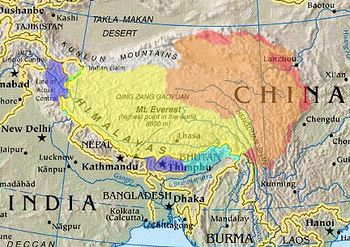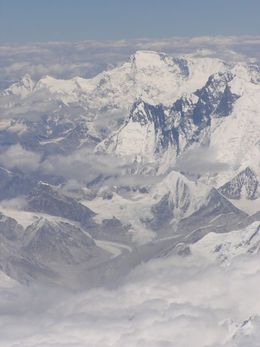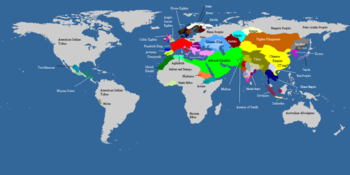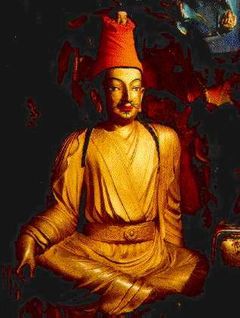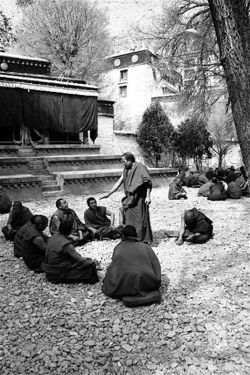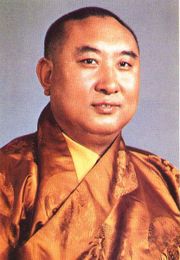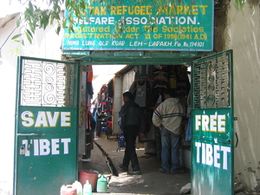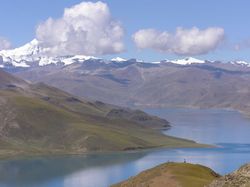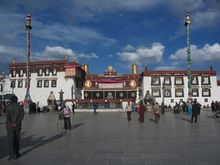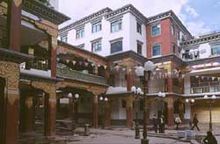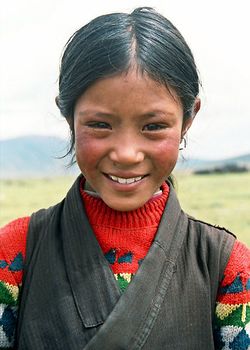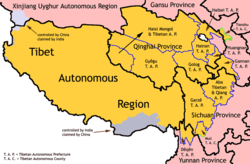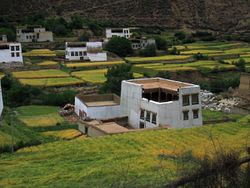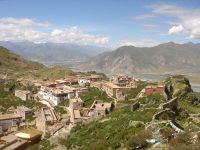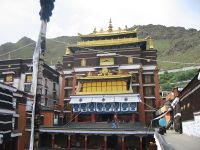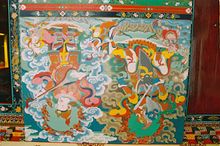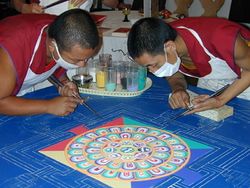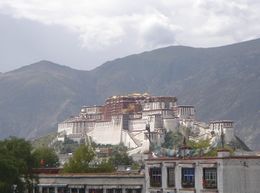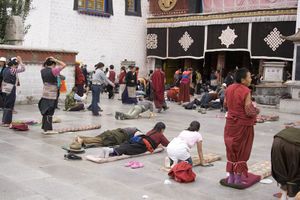التبت
- هذا المقال عن منطقة تاريخية تسمى "التبت" يمكنك الإطلاع أيضا على تبت (منطقة حكم ذاتي).
| Historic Tibet as claimed by Tibetan exile groups | |||||||||
| Tibetan areas designated by the PRC | |||||||||
| Tibet Autonomous Region (actual control) | |||||||||
| Claimed by الهند as part of Aksai Chin | |||||||||
| Claimed by PRC as part of TAR | |||||||||
| Other areas historically within Tibetan cultural sphere | |||||||||
تبت (تبتية: བོད་، Bod، تلفظ pö; صينية : 西藏، بنيانية: Xīzàng) هي منطقة ودولة سابقة في آسيا الوسطى وموطن الشعب التبتي. بمعدل إرتفاع 4900 متر ، تسمى أحيانا بـ"سقف العالم". وعندما يتحدث التبتيون والحكومة التبتية في المنفى عن التبت فهم يشيرون إلى منطقة واسعة التي شكلت التبت التاريخية لقرون، مكونة من مقاطعات أمدو، خام واو-تسانج. وعندما تتحدث الحكومة الصينية (والجهات الحكومية الرسمية للدول الاخرى) عن التبت ، فإنهم يشيرون إلى منطقة تتمتع بالحكم الذاتي تسمى التبت. وهي تشكل مقاطعة أوتسانج السابقة وغرب خام، والمناطق التبتية التقليدية الاخرى تم دمجها في الحدود الحالية لمقاطعة قنخهاي، غانسو ، يونان وسيشوان. وحكومة جمهورية الصين الشعبية تقول بتبعية المناطق المسيطر عليها هنديا من مقاطعة آروناخال براديش، وهو أمر لا تقره الحكومة التبتية في المنفى.
تعريفات التبت

الاسم
بالتبتية
بالصينية
بالإنجليزية
اللغة
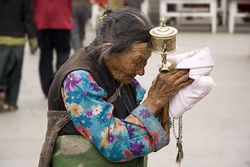
التاريخ
 مقالة مفصلة: تاريخ التبت
مقالة مفصلة: تاريخ التبت
قبل التاريخ
الامبراطورية التبتية
المنغول وأسرة يوان
الغزو البريطاني
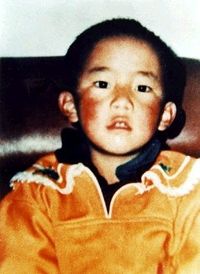
تقييم مجتمع المنفى التبتي

الجغرافيا
المدن والقرى
الاقتصاد
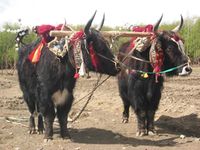
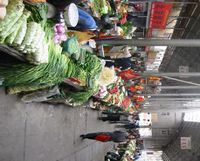
الديمغرافيا

| المجموعات العرقية الرئيسية في التبت الكبرى حسب المنطقة, تعداد 2000. | |||||||
|---|---|---|---|---|---|---|---|
| الإجمالي | التبتيون | الهان الصينيون | غيرهم | ||||
| منطقة التبت المستقلة ذاتياً: | 2,616,329 | 2,427,168 | 92.8% | 158,570 | 6.1% | 30,591 | 1.2% |
| - لهاسا PLC | 474,499 | 387,124 | 81.6% | 80,584 | 17.0% | 6,791 | 1.4% |
| - مقاطعة قمدو | 586,152 | 563,831 | 96.2% | 19,673 | 3.4% | 2,648 | 0.5% |
| - مقاطعة شانـّان | 318,106 | 305,709 | 96.1% | 10,968 | 3.4% | 1,429 | 0.4% |
| - Xigazê Prefecture | 634,962 | 618,270 | 97.4% | 12,500 | 2.0% | 4,192 | 0.7% |
| - Nagqu Prefecture | 366,710 | 357,673 | 97.5% | 7,510 | 2.0% | 1,527 | 0.4% |
| - Ngari Prefecture | 77,253 | 73,111 | 94.6% | 3,543 | 4.6% | 599 | 0.8% |
| - Nyingchi Prefecture | 158,647 | 121,450 | 76.6% | 23,792 | 15.0% | 13,405 | 8.4% |
| Qinghai Province: | 4,822,963 | 1,086,592 | 22.5% | 2,606,050 | 54.0% | 1,130,321 | 23.4% |
| - Xining PLC | 1,849,713 | 96,091 | 5.2% | 1,375,013 | 74.3% | 378,609 | 20.5% |
| - Haidong Prefecture | 1,391,565 | 128,025 | 9.2% | 783,893 | 56.3% | 479,647 | 34.5% |
| - Haibei AP | 258,922 | 62,520 | 24.1% | 94,841 | 36.6% | 101,561 | 39.2% |
| - Huangnan AP | 214,642 | 142,360 | 66.3% | 16,194 | 7.5% | 56,088 | 26.1% |
| - Hainan AP | 375,426 | 235,663 | 62.8% | 105,337 | 28.1% | 34,426 | 9.2% |
| - Golog AP | 137,940 | 126,395 | 91.6% | 9,096 | 6.6% | 2,449 | 1.8% |
| - Gyêgu AP | 262,661 | 255,167 | 97.1% | 5,970 | 2.3% | 1,524 | 0.6% |
| - Haixi AP | 332,094 | 40,371 | 12.2% | 215,706 | 65.0% | 76,017 | 22.9% |
| Tibetan areas in Sichuan province | |||||||
| - Ngawa AP | 847,468 | 455,238 | 53.7% | 209,270 | 24.7% | 182,960 | 21.6% |
| - Garzê AP | 897,239 | 703,168 | 78.4% | 163,648 | 18.2% | 30,423 | 3.4% |
| - Muli AC | 124,462 | 60,679 | 48.8% | 27,199 | 21.9% | 36,584 | 29.4% |
| Tibetan areas in Yunnan province | |||||||
| - Dêqên AP | 353,518 | 117,099 | 33.1% | 57,928 | 16.4% | 178,491 | 50.5% |
| Tibetan areas in Gansu province | |||||||
| - Gannan AP | 640,106 | 329,278 | 51.4% | 267,260 | 41.8% | 43,568 | 6.8% |
| - Tianzhu AC | 221,347 | 66,125 | 29.9% | 139,190 | 62.9% | 16,032 | 7.2% |
| Total for Greater Tibet: | |||||||
| With Xining and Haidong | 10,523,432 | 5,245,347 | 49.8% | 3,629,115 | 34.5% | 1,648,970 | 15.7% |
| Without Xining and Haidong | 7,282,154 | 5,021,231 | 69.0% | 1,470,209 | 20.2% | 790,714 | 10.9% |
الجدول[1] includes all Tibetan autonomous entities in the People's Republic of China, plus Xining PLC and Haidong P. The latter two are included to complete the figures for Qinghai province, and also because they are claimed as parts of Greater Tibet by the Government of Tibet in exile.
P = Prefecture; AP = Autonomous prefecture; PLC = Prefecture-level city; AC = Autonomous county.
Excludes members of the People's Liberation Army in active service.
الثقافة
| أظهر
جزء من سلسلة عن البوذية التبتية |
|---|

الديانات
البوذية التبتية
 مقالة مفصلة: البوذية التبتية
مقالة مفصلة: البوذية التبتية
بون
 مقالة مفصلة: بون
مقالة مفصلة: بون
Bön is the ancient traditional religion of Tibet, however it is now eclipsed by Buddhism in the area.
الإسلام
 مقالة مفصلة: الإسلام في التبت
مقالة مفصلة: الإسلام في التبت
في المدن التبتية, there are also small communities of Muslims, known as Kachee (Kache), who trace their origin to immigrants from three main regions: Kashmir (Kachee Yul in ancient Tibetan), Ladakh and the Central Asian Turkic countries. Islamic influence in Tibet also came from Persia. After 1959 a group of Tibetan Muslims made a case for Indian nationality based on their historic roots to Kashmir and the Indian government declared all Tibetan Muslims Indian citizens later on that year. There is also a well established Chinese Muslim community (gya kachee), which traces its ancestry back to the Hui ethnic group of China. It is said that Muslim migrants from Kashmir and Ladakh first entered Tibet around the 12th century. Marriages and social interaction gradually led to an increase in the population until a sizable community grew up around Lhasa.[بحاجة لمصدر]
الأديرة البوذية في التبت
Notable monasteries:
- Ani Tsankhung Nunnery
- Changzhu Temple
- Chokorgyel Monastery
- Dorje Drak
- Drepung Monastery
- Drigung Monastery
- Dzogchen Monastery
- Ganden Monastery
- Jokhang
- Khorzhak Monastery
- Kumbum Monastery (Kham)
- Labrang Monastery
- Menri Monastery
- Namgyal Monastery
- Narthang Monastery
- Nechung
- Palcho Monastery
- Ralung Monastery
- Ramoche Temple
- Sakya Monastery
- Sanga Monastery
- Sera Monastery
- Shalu Monastery
- Shechen Monastery
- Simbiling Monastery
- Surmang Monastery
- Tashilhunpo
- Tsurphu Monastery
- Yerpa
الفن التبتي
العمارة
الموسيقى
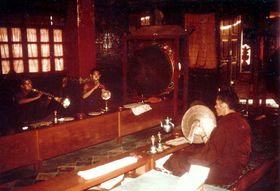
المهرجانات
المطبخ
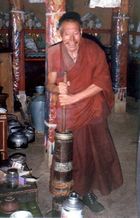
التبت في الثقافة العالمية

معرض صور
Tibetan children in Lithang
المصادر
- ^ Department of Population, Social, Science and Technology Statistics of the National Bureau of Statistics of China (国家统计局人口和社会科技统计司) and Department of Economic Development of the State Ethnic Affairs Commission of China (国家民族事务委员会经济发展司), eds. Tabulation on Nationalities of 2000 Population Census of China (《2000年人口普查中国民族人口资料》). 2 vols. Beijing: Nationalities Publishing House (民族出版社), 2003 (ISBN 7-105-05425-5).
قراءات اضافية
- Allen, Charles (2004). Duel in the Snows: The True Story of the Younghusband Mission to Lhasa. London: John Murray, 2004. ISBN 0-7195-5427-6.
- Bell, Charles (1924). Tibet: Past & Present. Oxford: Clarendon Press.
- Dowman, Keith (1988). The Power-Places of Central Tibet: The Pilgrim's Guide. Routledge & Kegan Paul. London, ISBN 0-7102-1370-0. New York, ISBN 0-14-019118-6.
- Goldstein, Melvyn C.; with the help of Gelek Rimpoche. A History of Modern Tibet, 1913-1951: The Demise of the Lamaist State. Munshiram Manoharlal Publishers (1993), ISBN 81-215-0582-8. University of California (1991), ISBN 0-520-07590-0.
- Grunfeld, Tom (1996). The Making of Modern Tibet. ISBN 1-56324-713-5.
- Gyatso, Palden (1997). "The Autobiography of a Tibetan Monk". Grove Press. NY, NY. ISBN 0-8021-3574-9
- Human Rights in China: China, Minority Exclusion, Marginalization and Rising Tensions, London, Minority Rights Group International, 2007
- McKay, Alex (1997). Tibet and the British Raj: The Frontier Cadre 1904-1947. London: Curzon. ISBN 0-7007-0627-5.
- Norbu, Thubten Jigme; Turnbull, Colin (1968). Tibet: Its History, Religion and People. Reprint: Penguin Books (1987).
- Pachen, Ani; Donnely, Adelaide (2000). Sorrow Mountain: The Journey of a Tibetan Warrior Nun. Kodansha America, Inc. ISBN 1-56836-294-3.
- Parenti, Michael (2004)."Friendly Feudalism: The Tibet Myth".
- Petech, Luciano (1997). China and Tibet in the Early XVIIIth Century: History of the Establishment of Chinese Protectorate in Tibet. T'oung Pao Monographies, Brill Academic Publishers, ISBN 9-00403-442-0.
- Samuel, Geoffrey (1993). Civilized Shamans: Buddhism in Tibetan Societies. Smithsonian ISBN 1-56098-231-4.
- Schell, Orville (2000). Virtual Tibet: Searching for Shangri-La from the Himalayas to Hollywood. Henry Holt. ISBN 0-8050-4381-0.
- Shakya, Tsering (1999). The Dragon in the Land of Snows: A History of Modern Tibet Since 1947. New York: Columbia University Press. ISBN 0-231-11814-7.
- Smith, Warren W. (Jr.) (1996). Tibetan Nation: A History of Tibetan Nationalism and Sino-Tibetan Relations. Boulder, CO: Westview Press. ISBN 0-8133-3155-2.
- Stein, R. A. (1962). Tibetan Civilization. First published in French; English translation by J. E. Stapelton Driver. Reprint: Stanford University Press (with minor revisions from 1977 Faber & Faber edition), 1995. ISBN 0-8047-0806-1.
- Thurman, Robert (2002). Robert Thurman on Tibet. DVD. ASIN B00005Y722.
- Wilby, Sorrel (1988). Journey Across Tibet: A Young Woman's 1,900-mile (3,060 km) Trek Across the Rooftop of the World. Contemporary Books. ISBN 0-8092-4608-2.
- Wilson, Brandon (2004). Yak Butter Blues: A Tibetan Trek of Faith. Pilgrim's Tales. ISBN 0977053660, ISBN 0977053679. (second edition 2005)
- Wang Jiawei (2000). "The Historical Status of China's Tibet". ISBN-7-80113-304-8.
- Tibet wasn't always ours, says Chinese scholar by Venkatesan Vembu, Daily News & Analysis, 22 February 2007
منذ 1959 ، قامت الحكومة التبتية السابقة ، بقيادة الدالاي لاما الرابع عشر تنزين غياتسو ، قامت بالحفاظ على حكومة تبتية في المنفى في دارامسالا في شمال الهند. وهي تقول بحقها بالسيادة على التبت، بحدود تطلق عليها هذه الحكومة "التبت التاريخية".
لاهاسا، عاصمة التبت التقليدية كما هي عاصمة منطقة التبت المحكومة ذاتيا. مدن اخرى في التعريف الأوسع للتبت تشمل شيغاتسه ، غيانغسه، كامدو وغيرها.
وصلات خارجية
ضد الحكم والسياسات الصينية في التبت
- Tibetan Government in Exile's government site
- The Sky Burials of Tibet
- Students for a Free Tibet's website
- People's Movement For An Independent Tibet
- Tibetan Review
- The International Campaign for Tibet
- Tibet News Site
- Tibet Online
- Australia Tibet Council
- Save Tibet-Austria
- Team for Tibet (Belgium)
- Etudiants pour un Tibet Libre (Students for a Free Tibet - France)
- de l'association France Tibet
- Tibet Info (France)
مع الحكم والسياسات الصينية في التبت
- Tibetan History on the China Tibet Information Center of the PRC
- White Paper on Tibetan Culture and Homa
غير سياسية
- Tibetan Studies Internet Resources
- Tibetan Aid Project
- Pictures of Tibet
- Haiwei Trails - Timeline of Tibet
- The Language of Tibet
- Tibet Photo Gallery - A complete Travel Photos
- التبت travel guide from Wikitravel
| أظهر مناطق النزاع في شرق، جنوب، وجنوب شرق آسيا |
|---|
